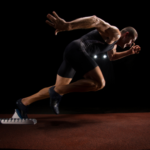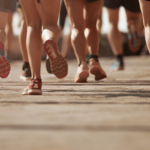The processes of human growth and development are intricate and begin very early in life. These processes undergo significant changes with the passage of time such as in childhood and adolescence. Several factors such as genetics, nutrition, and hormonal changes greatly affect one’s height and why it is regarded as a key feature of physical growth. While genetics are a major aspect of an individual’s height, nutrition and hormonal balance are also equally important. Nutrition is vital for children as they develop at various stages from childhood to adolescence because the human body goes through drastic changes during these phases.
Growth plates are crucial factors when considering height in individuals. This area is made up of developing cartilage tissue and is found at the ends of long bones. It is responsible for bones getting longer during growth years. The growth plates gradually ossify as children and adolescents get older, which means the bones will not grow anymore. This is why height increase is very prominent and observable in children when the growth plates are active. The average age for females to stop growing is 18, and for males it is 21.
In addition to genetics and growth plates, hormones also play a significant role in growth. Growth hormone, released by the pituitary gland, is particularly influential during periods of rapid growth. Other hormones, such as thyroid hormones and sex hormones, also contribute to bone growth and overall development. Understanding these factors helps explain why certain activities, like physical exercise, can support healthy growth during the development phase.
The Impact Of Physical Activity On Growth
A child, a youth, and an adult all seem to benefit from physical activity. It is part of an active lifestyle. Regularly exercising and Physically Being Active contributes to a person’s overall wellbeing. Aside from supporting a person’s growth and development, exercise also helps maintain bone strength and health, posture, and one’s previously mentioned potential for growth. It is essential to comprehend how everyday fitness activities and sports like running or jumping and strength exercises in relation to the potential impact a person has on an individual’s growth.
One of the most powerful points is the enhancement of bone strength and density for different activities. Burdening exercises such as running, vertically have a fundamental change on the bone mass of an individual. When done appropriately, this type of physical activity fortifies bones by triggering quads and bone building activities. This is suitable for children and adolescence. Activities is also a great representation of good underpinned, as it can improve one’s position with a specific purpose of enhancing one’s self perceived status. Flexibility, as well as a good body posture and straighter stature, is said to result from stretching and strengthening exercises.
Another factor that is greatly affected by physical activity is the synthesis of growth hormone. It has been confirmed that exercising, particularly during vigorous exercises like jogging, helps increase the secretion of growth hormones from the pituitary gland. These growth hormones are critical for transforming and developing bones and many other parts of the body. Even though running does not, as such, increases height, it can actively increase the secretion of growth hormone during adolescence and aid in skeletal development of the body. While it is true that exercise offers these benefits, it is also true that there is no method to increase height further than genetic limitations.
Here are some key benefits of physical activity for growth:
- Increases bone density: Weight-bearing exercises like running promote bone health and strength.
- Stimulates growth hormone release: Physical activity encourages the secretion of growth hormones, which support overall growth.
- Improves posture: Activities that focus on stretching and flexibility enhance posture, leading to better alignment and a taller appearance.
- Supports healthy growth: Regular physical activity during growth periods ensures that bones and muscles develop optimally.
- Enhances flexibility: Improved flexibility from exercises like stretching helps with posture, which can make a person look taller.
While running is beneficial in supporting growth hormone production, it is important to note that these benefits are more pronounced during the growth periods of childhood and adolescence. In adulthood, physical activity, while still important for overall health, does not directly impact height since the growth plates have already closed. However, maintaining a physically active lifestyle remains crucial for general health and wellness, and it helps to preserve bone density and flexibility well into adulthood.
Running And Its Effects On Height
When it comes to cardiovascular exercises, many people believe running is one of the most beneficial. Its advantages are not limited to just fitness as running can improve bone growth and physical development. While running per se cannot bring about an increase in height, there are various ways in which it aids in promoting growth, including overall health, during the youth growth periods.
Running has many positive effects on human beings, the most critical one being bone health. Bony structures are strengthened by enhancing the density of bones and since running is a weight supporting activity, it facilitates this. It is vital during the childhood and young teenage years as bones are still developing. Training or running on a regular basis helps in making stronger bones, and improves the bone mass and even strong and healthy bones. Further, running induces the correct posture of the body, which is important in the maintenance of the body. Good posture is important because it can improve a person’s physical appearance by making them look taller and more aligned to their body.
The Role Of Growth Hormones In Running
Running also has an indirect impact on height due to its influence on growth hormone production. Growth hormones, produced by the pituitary gland, are vital for stimulating bone growth during the developmental years. Physical activity like running can increase the secretion of growth hormones, especially during high-intensity exercises. These hormones promote the elongation of bones and the overall development of the skeletal structure, which supports the body’s natural growth processes. However, it’s essential to recognize that the increase in growth hormone production from running will not lead to height increases beyond what is genetically determined. While running can help ensure that a person reaches their full height potential, “Does running make you taller” is ultimately dependent on genetic factors.
Scientific Studies On Running And Height
Considerable research has been conducted exploring the correlation between exercise and growth, particularly the influence of different forms of exercises on the bone structure and other developmental aspects. Running, being a very popular form of exercise, and its relationship with growth are studied to determne if there is a direct effect on height. Evidence suggests running improves bone health and posture, but has little effect on height increase past genetic potential. Despite this, there are useful observations on how running aids body benefits during growth.
A Journal of Pediatrics study investigated the impacts of some sports, particularly running, on the growth of children. It was noted that participation in physical activity on a regular basis has a beneficial effect on bone growth and formation and the rate at which growth is occuring by improving bone strength and density and the condition of the whole skeletal system. Similar information was noted in a study published in the Clinical Journal of Sport Medicine where children with a high physical activity level were reported to have healthier growth plates necessary for bone elongation in adolescents which is sustained by running and other moderate exercises.
In ‘Research on Growth Development’ from the ‘European Journal of Applied Physiology’, it has been discovered that aerobic exercises such as running have the ability to increase the secretion of growth hormones. These hormones are crucial in tissue and bone development. The hormone benefits are more effective, however, in the years leading up to the closure of growth plates.
| Study Title | Key Findings |
| Journal of Pediatrics | Regular physical activity positively impacts bone development. |
| Clinical Journal of Sport Medicine | Moderate, weight-bearing exercises like running help maintain healthy growth plates. |
| European Journal of Applied Physiology | Running stimulates the release of growth hormones, supporting bone growth. |
Following these findings, it’s clear that running supports healthy growth and bone development but does not directly increase height. The benefits of running are particularly noticeable during the growth years when the body is still in a phase of rapid development. As the body matures, the impact of running on height diminishes since growth plates close after adolescence.
Running continues to be an excellent exercise for promoting overall health, maintaining bone density, and supporting hormonal balance. Although it may not make individuals taller, the numerous health benefits it provides make it an essential activity for maintaining a healthy body and lifestyle.
Factors Influencing The Impact Of Running On Height
When trying to determine if running can affect height there are various factors that contribute to the effects of exercise on growth. Although running has several advantages in terms of health, the one concerning height is determined by genetic factors, age, nutrition, and the relationship of the timing of the exercise to the growth phases. It is clear that running can aid growth processes in the body, but do not change the potential genetic height of a person.
Age And Developmental Stage
The impact of running on height is most significant during the growth phases of childhood and adolescence. During these years, the body is still developing, and bones are lengthening. Running, as a weight-bearing exercise, can stimulate bone growth and enhance bone density, contributing to overall skeletal health. The body’s growth plates, which are responsible for the lengthening of bones, remain open during this period, making it the optimal time for physical activities like running to have a noticeable impact. However, once growth plates close, usually around the age of 18 to 21, “Does running make you taller” will no longer have any effect on increasing height. At this stage, the body has already reached its genetic potential for height, and physical activities can no longer change that.
Nutrition And Its Role In Growth
Proper nutrition is equally as important as running in supporting height. Sufficient quantity of vitamins and minerals such as calcium and vitamin D is critical for health and bone development. This makes it possible for the body to have nutrients needed to strengthen bones and growth during development. Nutrition is one of the factors that can alter the benefits of running. A person may not be able to reach their height potential without proper nutrition. Different types of nutritional deficiencies, for example, less protein or lack of calcium, can inhibit a person’s bone growth which impacts their health condition.
Genetics: The Key Determinant Of Height
Genetics ultimately has the highest impact on a person’s height. For example, running can aid healthy growth and bone development, but there exists a limit beyond which running will not be effective. Each person is genetically made in such a way that there exists a maximum limit for height, and this particular factor cannot be altered. However, nutrition and physical activity can only assist in attaining that limit. So, for example, if someone wishes to know if running makes one taller, the answer is yes, but only during one’s growing years. Running will not change the genetic height blueprint however.
Potential Risks Of Running On Growth
While running is a beneficial form of exercise for overall health and well-being, it is important to consider the potential risks, especially for growing individuals. Excessive or improper running can lead to injuries and complications that may negatively impact bone health and development. It is essential to balance physical activity with proper rest, recovery, and nutrition to ensure that the benefits of running are maximized and the risks are minimized. Below are some of the risks associated with running that can impact growth.
- Overtraining: Excessive running without adequate rest can lead to overtraining syndrome, which may cause stress fractures or injuries that hinder growth.
- Injury from Improper Technique: Poor running form or inadequate footwear can result in injuries that affect bone health, such as shin splints or knee problems.
- Nutritional Deficiencies: Intense physical activity, like running, requires sufficient energy and nutrients. Running without proper nutrition may lead to deficiencies, affecting bone health and overall growth.
- Growth Plate Injuries: In growing children, overuse injuries, such as stress fractures, can damage growth plates and potentially disrupt normal bone growth.
- Inadequate Rest and Recovery: Running without proper recovery time can lead to fatigue and an increased risk of injury, which may hinder optimal bone development.
These risks must be managed to ensure a stable ratio, albeit they ought not dissuade people from engaging in exercise. Young sportsmen are perhaps the youngest and most susceptible age group pushing themselves into overtraining. To stave off overtraining syndrome, one should take rest days and limit mileage. Also, running injuries that can adversely affect growth can be avoided by focusing on technique and footwear selection.
Just as one’s diet is pivotal to foster growth, bones strength and aid nutrition greatly to a person who enjoys activities such as running, nutrition is of equal importance when it comes to running. Sufficient amounts of calcium and vitamin D fortify a diet while strong bones, assist in growth. Otherwise, the person might suffer more consequential injuries and lose the advantages, if any, of running. In conclusion, making sure that rest, nutrition, and technique are kept at a healthy ratio with physical activity leads to injury free running while taking full advantage of the activity.
The Role Of Running In Supporting Growth And Bone Health
Running has many benefits to one’s general health and is one of the best forms of exercise due to its weight-bearing nature. While running during childhood and adolescence is most beneficial, it can greatly improve one’s bone structure and overall growth. Even though it does not have a direct impact on one’s height, it greatly improves one’s posture. Stimulating bone density through running is essential, especially when the body is still growing. Additionally, running boosts flexibility which results in good posture, making one appear taller while being well-aligned.
Further, running during growth periods also promotes the secretion of growth hormones. These hormones, which are released from the pituitary gland, are central to the growth and development of bones and body tissues. To enhance the growth processes, one needs to integrate running and other exercises to their routine. However, running more greatly impacts one’s height during active growth phases before the growth plates fuse.
It is important to note that while running plays a supportive role in the body’s development, it does not change a person’s genetic potential for height. The key to maximizing growth potential lies in balancing physical activity, proper nutrition, and overall well-being. “Does running make you taller?” Ultimately, running is an excellent activity for supporting growth, but its effect on height is limited by genetic factors.






